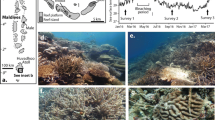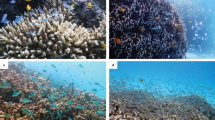Abstract
Recently, questions about the health of the coral reefs of the Florida Keys have been raised. Estimates of net recruitment and mortality of reef corals on Carysfort Reef, Key Largo, Florida, suggest that these populations declined over the 14 month interval studied. The greatest rate of change on Carysfort Reef, the most well developed reef in the northern Keys, occurred in the zone of richest coverage by corals. Water pollution associated with the tremendous increase in the human population of South Florida in the last twenty years may be contributing to the reef's decline.
Similar content being viewed by others
References Cited
Antonius, A., 1974, Sedimentation project final report: Fort Pierce, Florida, Harbor Branch Foundation Inc., 225 p.
Barada, B., 1975, Keys dive guides fight to save coral: Skin Dive Magazine, v. 24, no. 12, p. 40–45.
Connell, J., 1973, Population ecology of reef-building corals,in Jones, A. O., and R. Endean, eds., The geology and biology of coral reefs, v. New York, Academic Press, p. 205–244.
Dustan, P., 1977, The impact of man on coral reefs: physical destruction on John Pennekamp Coral Reef State Park: Natural History, v. 38, no. 4, p. 72–76.
Ferguson-Wood, E. J., and R. E. Johannes, 1975, Tropical marine pollution: New York, American Elsevier Pub. Co., 192 p.
Garrett, P., and H. Ducklow, 1975, Coral diseases in Bermuda: Nature v. 253, p. 349–350.
Goreau, T. F., 1959, The ecology of Jamaican coral reefs: Ecology, v. 40, p. 67–90.
Goreau, T. F., and N. I. Goreau, 1973, The ecology of Jamaican coral reefs, II: geomorphology, zonation and sedimentary phases: Bull Mar. Sci., v. 23, p. 399–464.
Griffin, G., 1974, Sedimentation project, final report: Fort Pierce, Florida Harbor Branch Foundation Inc., 225 p.
Hubbard J., and Y. P. Pocock, 1972, Sediment rejection by scleratinian corals; a key to palaeoenvironmental reconstruction: Geol. rundsch., v. 61, p. 598–626.
Johannes, R. B., 1970, Coral reefs and pollution: Rome, UNESCO, Fisheries Rpt. no. 99, p. 1–15.
Jordan, G. F., R. J. Malloy, and J. W. Kofoed, 1964, Bathmetry and geology of Portules Terrace, Florida: Marine Geology, v. 1, p. 259–287.
Mitchell, R., and I. Chet, 1975, Bacterial attack of corals in seawater: Microb. Ecology, v. 2, p. 227–233.
Ott, Bruce, and John B. Lewis, 1972, The importance of theCoralliophila abbreviata (Lamarck) and the polychaetecarunculata (Pallas) as coral reef predators: Canadian Jour. Zoolog v. 50, no. 12, p. 1651–1656.
U.S. Public Health Service, 1962, Inventory of municipal waste facilities by Public Health Service Regions: U.S. Public Health Service, 1065, v. 5, 133 p.
Author information
Authors and Affiliations
Rights and permissions
About this article
Cite this article
Dustan, P. Vitality of reef coral populations off Key Largo, Florida: Recruitment and mortality. Geo 2, 51–58 (1977). https://doi.org/10.1007/BF02430665
Issue Date:
DOI: https://doi.org/10.1007/BF02430665




